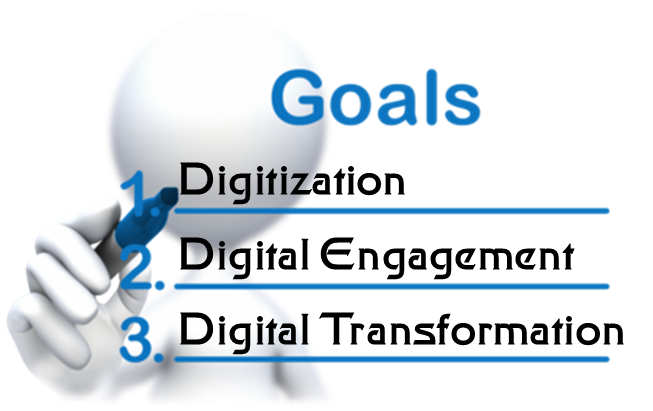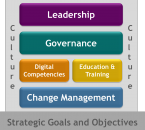[vc_row][vc_column width=”1/1″][vc_row_inner][vc_column_inner width=”1/4″][vc_column_text css=”.vc_custom_1423530342372{padding-top: 20px !important;}”] [/vc_column_text][/vc_column_inner][vc_column_inner width=”3/4″ css=”.vc_custom_1424118038600{padding-top: 10px !important;}”][vc_column_text]This Social Media Today Best Thinkers piece offers a quick assessment of where business schools are in their digital transformation journeys, provides examples of the possibilities being exploited by some leading schools, and highlights areas that require greater attention. A follow-up piece offers suggestions for how business school leaders can continue to adapt to Digital Era realities and demonstrate Digital Era leadership.[/vc_column_text][/vc_column_inner][/vc_row_inner][divider_line type=”divider_line”][vc_column_text]In my last Best Thinkers essay, I talked about how all business functions – not just customer focused areas like marketing and sales – are being transformed by social and digital technologies. The ideas I shared there complement my earlier discussion about how we’re all becoming tech workers and therefore need to have high degrees of digital literacy and competence.
[/vc_column_text][/vc_column_inner][vc_column_inner width=”3/4″ css=”.vc_custom_1424118038600{padding-top: 10px !important;}”][vc_column_text]This Social Media Today Best Thinkers piece offers a quick assessment of where business schools are in their digital transformation journeys, provides examples of the possibilities being exploited by some leading schools, and highlights areas that require greater attention. A follow-up piece offers suggestions for how business school leaders can continue to adapt to Digital Era realities and demonstrate Digital Era leadership.[/vc_column_text][/vc_column_inner][/vc_row_inner][divider_line type=”divider_line”][vc_column_text]In my last Best Thinkers essay, I talked about how all business functions – not just customer focused areas like marketing and sales – are being transformed by social and digital technologies. The ideas I shared there complement my earlier discussion about how we’re all becoming tech workers and therefore need to have high degrees of digital literacy and competence.
As business functions and the related professional fields become increasingly transformed by social and digital technologies, there’s a corresponding need for the academic institutions that prepare the individuals who work in these areas to undergo their own digital transformations. In this piece I offer a quick assessment of where business schools are in their digital transformation journeys, provide examples of the possibilities being exploited by some leading schools, and highlight areas that require greater attention.
Although focused on business schools, the ideas in this essay can also be applied to other professional schools like law, public health, social work, education, public administration, etc.
[/vc_column_text][/vc_column][/vc_row][vc_row][vc_column width=”1/1″][vc_column_text css=”.vc_custom_1423529018977{padding-bottom: 5px !important;}”]
Digitization
[/vc_column_text][vc_column_text]Digitization is the first step to becoming a digital organization. Externally, this basically involves having a website and converting paper-based forms of one-way communication (e.g., newsletters) to their digital equivalents (i.e., email blasts). It can also include the shift from newspaper and magazine ads to search engine and other forms of digital advertising.
Internally, in addition to automating operations (e.g., accounting, payroll) through a variety of software programs and systems, digitization manifests itself in the conversion of paper-based documents, one-way communications, and administrative processes to their digital equivalents (e.g., putting a policy manual online).
Like most organizations, business schools are generally fairly well digitized, with many of their digitization efforts (e.g., online course programs and enrollment, apps for attendance and testing) being part of larger university initiatives. Digitization efforts will continue as new technologies become available, of course, but it’s fair to say that the commitment to digitization is well established.[/vc_column_text][/vc_column][/vc_row][vc_row][vc_column width=”1/1″][vc_column_text css=”.vc_custom_1423529061487{padding-bottom: 5px !important;}”]
Digital Engagement
[/vc_column_text][vc_column_text]The next phase in the journey to becoming a digital organization is digital engagement. Email is the most basic and well-established method of digital engagement for both external and internal communication and collaboration, and it’s a technology that all organizations have adopted (even if it’s a technology most people love to hate).
For most organizations, more advanced forms of digital engagement begin with an external focus, emphasizing marketing, branding, sales, public relations and customer service. Moving beyond the one-way communications of traditional websites and email blasts, it typically involves things like setting up some form of e-commerce, creating and managing a blog, and establishing a presence on social media channels like LinkedIn, Twitter, Facebook, YouTube, Pinterest, etc. Depending on the organization, it can also involve creating and implementing some kind of mobile app that facilitates customer transactions and engagement.
Internally, digital engagement manifests itself in the implementation or upgrading of an organization’s intranet using a software solution that incorporates more social features (aka a social intranet, or intranet 2.0). These features include things like user-generated profiles, the ability for employees to form internal networks and groups, internal blogs, status updates, chatting or instant messaging, etc. The basic idea is to provide more sophisticated tools that improve both the efficiency and effectiveness of internal communication and collaboration.
As with digitization, basic forms of digital engagement are evident in most business schools, particularly when it comes to external communication (i.e., websites and social media activity). Although the commitment is clear and ongoing, there is an increasing need to ensure social and digital engagement efforts are streamlined, goal-focused, professionally managed and maximally effective. The days of myriad presences with relatively small followings managed by multiple “volunteers” who potentially cannibalize each other’s activities and undermine a school’s objectives need to become a thing of the past.
Internally, the strongest applications of digital engagement are course management systems like Blackboard and the platforms that support online learning. Pedagogically, some instructors have also incorporated social and digital technologies into their teaching methods and student assignments. Blogging, for example, is a great way to promote reflective learning. In addition to writing papers, students can create videocasts and podcasts and slideshows as means of conveying information and ideas. And wikis and other tools can be used to promote knowledge creation and sharing, manage projects, enhance communication skills, etc.
The biggest opportunity for business schools when it comes to internal digital engagement is the development and implementation of private social networks. In addition to reducing potential risks of using public channels for private communication (e.g., between teachers and students), these networks will enable students and faculty to communicate with each other outside the confines of a particular course and can also facilitate communication and collaboration among faculty and staff.[/vc_column_text][/vc_column][/vc_row][vc_row][vc_column width=”1/1″][vc_column_text css=”.vc_custom_1423529132799{padding-bottom: 5px !important;}”]
Digital Transformation
[/vc_column_text][vc_column_text]Digital transformation reflects the full integration of social and digital technologies into an organization’s operations in ways that make the most sense given an organization’s goals and objectives. It can also involve changes in strategic direction.
When it comes to the business school operating model, the most established form of digital transformation is likely in course delivery methods, initially through distance education and more recently through online and hybrid courses. Some elite schools, like Stanford and UNC’s Kenan-Flagler Business School, have even started offering fully online executive and MBA programs.
There are also signs of progress in terms of research, with social and digital technologies creating new opportunities with respect to questions to be explored, data sources and research methodologies, and the sharing of study results. Nine of ScienceDirect’s “hottest”25 articles in Business, Management, and Accounting from July to September 2014, for example, clearly involved social and digital technologies. And the program from the Academy of Management’s 2014 Annual Meeting included papers, presentations, and workshops on topics like social media, big data, crowdsourcing and crowdfunding, and mobile technology.
Taking things a step further, some institutions have created research centers that are supported by leading firms that serve as both sponsors and collaborators. MIT’s Sloan School of Management is notable in this regard. They have an Initiative on the Digital Economy and a Center for Digital Business, and have co-produced research like Moving Beyond Marketing: Generating Social Business Value across the Enterprise (with Deloitte) and the Digital Transformation Global Research Study (with Capgemini).
As the Digital Era continues to progress, the research opportunities for both individual academics and business schools will only increase – and so will the challenges. Key among them will be ensuring that researchers abide by a set of ethical guidelines that manage the temptations created by virtually unlimited online datasets and respect the privacy and rights of individuals leveraging social and digital technologies in both their personal and professional lives (as discussed here).
Though it may come as a surprise, the most underdeveloped area in terms of digital transformation is the business school curriculum itself. In the years that I’ve been tracking the extent to which business schools are providing Digital Era leadership, I have seen little indication that Digital Era concerns are a strategic priority. In articles on undergraduate business school rankings, for example, a curricular focus on digital technologies is generally not discussed as a distinguishing feature of any school or program. And though the websites for the business schools themselves make many references to important topics like globalization, ethics, leadership, sustainability and community, they include virtually no recognition of the impact of social and digital technologies on the future of business and their students’ careers.
Recognizing that business schools are a “legacy industry” and the MBA is a “challenged brand,” some business schools are making a concerted effort to adapt to Digital Era realities (read more here and here). Cornell University, in partnership with Technion-Israel Institute of Technology, has even gone so far as to establish Cornell Tech, which offers a unique approach to MBA education. But this is an exception, far from the rule.
There have been changes in the marketing curriculum, of course, with the addition of courses on topics like ecommerce, digital and interactive marketing, and marketing analytics – but even that curriculum has not been significantly transformed in many schools. There are also some signs of curricular expansion in areas like business intelligence and big data/analytics, strategy, and entrepreneurship – usually just in the form of individual courses, but sometimes in the form of concentrations as well.
Business schools need to consider adding more courses and more concentrations, not just in the obvious areas like marketing, but throughout the curriculum. Additional required and elective courses could include things like Digital Era Legal Issues, Principles of Community Management, Behavioral Finance in Cyberspace, Recruiting in the Digital Era, and Leadership in the Digital Era. But even more important is the need to fully integrate Digital Era realities into all courses in which they’re likely to have an impact, including the basic courses in law, management, human resources, accounting, and finance.[/vc_column_text][/vc_column][/vc_row][vc_row][vc_column width=”1/1″][vc_column_text css=”.vc_custom_1423529893924{padding-bottom: 5px !important;}”]
Conclusion
[/vc_column_text][vc_column_text]In my next Best Thinkers essay I offer suggestions for how business school leaders can continue to adapt to Digital Era realities and demonstrate Digital Era leadership. In the meantime, I welcome your thoughts on the digital transformation of business (and other professional) schools. How important do you think it is for them to integrate Digital Era realities into their curricula, pedagogical approaches, research agendas, and operations? What other examples of progress do you see? What do you consider the most important areas for business school leaders to focus on?
This essay originally appeared on Social Media Today as part of their Best Thinkers program.[/vc_column_text][divider_line type=”divider_line”][/vc_column][/vc_row]






Comments
One response to “Assessing the Digital Transformation of Business Schools”